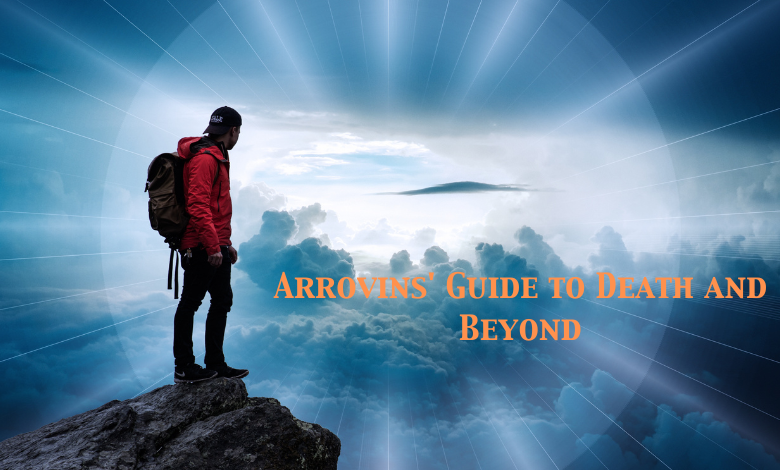Arrovins’ Guide to Death and Beyond

The idea of dying and the afterlife has involved humanity since the sunrise of civilization. Across unique cultures and religions, there are myriad interpretations of what happens after we die. Some envision a paradise or an area of punishment, even as others agree with in reincarnation or a religious adventure. Arrovins‘ Guide to Death and Beyond gives a completely unique attitude on these age-old questions, supplying perception into the mysterious realm that lies past our mortal existence.
The Nature of Death
Biological Perspective
From a scientific standpoint, demise is the cessation of all organic capabilities that sustain a residing organism. It is the stop of lifestyles, marked with the aid of the irreversible lack of crucial capabilities including heartbeat, mind activity, and respiration. Modern medicine has prolonged the boundary of existence, but it cannot indefinitely stave off the inevitability of loss of life.
Philosophical Perspective
Philosophically, dying raises profound questions about the which means of life. What happens to our recognition? Is there a soul that transcends the physical body? Philosophers like Socrates, Plato, and Descartes have pondered those questions, every supplying different interpretations of the nature of dying and the possibility of an afterlife.
The Journey Beyond
Cultural and Religious Beliefs
Ancient Egypt
In historic Egypt, loss of life was visible as a transition to another realm. The Egyptians believed in an afterlife where the soul could adventure to the Field of Reeds, a paradise that mirrored their earthly existence however free of suffering. The procedure involved various rituals, mummification, and the weighing of the heart against the feather of Ma’at, the goddess of reality and justice.
Christianity
Christianity teaches that demise is not the give up however a passage to eternal life. Believers hold that the soul either ascends to Heaven to be with God or descends to Hell as punishment for sins. The resurrection of Jesus Christ is vital to Christian notion, symbolizing victory over death and the promise of existence everlasting.
Hinduism and Buddhism
Hinduism and Buddhism both espouse the idea of reincarnation. According to those traditions, the soul undergoes a cycle of beginning, dying, and rebirth, prompted by way of karma, the sum of one’s actions. The ultimate purpose is to reap moksha (liberation) or nirvana (enlightenment), breaking unfastened from the cycle of rebirth.
Modern Spirituality
In modern instances, non secular ideals approximately the afterlife have diverse. Many humans draw on various traditions, non-public reviews, and new age philosophies to form their knowledge of death and what lies past. Practices such as close to-dying studies (NDEs) and mediumship have also contributed to fashionable conceptions of the afterlife.
Near-Death Experiences (NDEs)
Common Elements of NDEs
Near-dying experiences are said via individuals who have come near loss of life after which revived. Common elements of NDEs encompass:
- A sense of peace and detachment from the frame.
- Traveling thru a tunnel towards a bright light.
- Encounters with deceased loved ones or religious beings.
- A lifestyles assessment or flashback of extensive moments.
Scientific Investigations
NDEs were studied notably via scientists and medical professionals. While some argue that those experiences may be explained through brain hobby throughout worrying activities, others trust they provide proof of an afterlife. The debate keeps, with research ongoing to find the mysteries of NDEs.
Arrovins’ Perspective on Death and Beyond
Integration of Beliefs
Arrovins’ Guide to Death and Beyond seeks to integrate diverse cultural, religious, and philosophical beliefs approximately the afterlife. It gives a holistic view that acknowledges the diversity of human enjoy and interpretation. By exploring common themes and specific insights from exclusive traditions, the guide offers a comprehensive expertise of demise and what lies beyond.
Practical Advice for the Living
Beyond its exploration of the afterlife, Arrovins’ Guide affords practical recommendation for the dwelling. It emphasizes the importance of dwelling a significant lifestyles, cultivating compassion, and preparing for the inevitable transition of loss of life. The guide encourages readers to reflect on their ideals and are looking for non-public growth and knowledge.
Embracing the Mystery
Ultimately, Arrovins’ Guide to Death and Beyond embraces the thriller of the afterlife. It recognizes that, regardless of our satisfactory efforts, the proper nature of what happens once we die remains beyond human comprehension. The manual invites readers to technique the topic with an open mind and a experience of wonder, spotting that loss of life is an essential a part of the human revel in.
Conclusion
Death is a ordinary reality that touches each human lifestyles. Arrovins’ Guide to Death and Beyond presents a wealthy tapestry of insights from diverse traditions, assisting us navigate the unknown terrain of the afterlife. Whether considered via the lens of faith, philosophy, or private experience, the journey beyond loss of life stays one in every of lifestyles’s finest mysteries. By exploring those diverse views, we can benefit a deeper know-how of our own ideals and discover peace within the face of the unknown.



